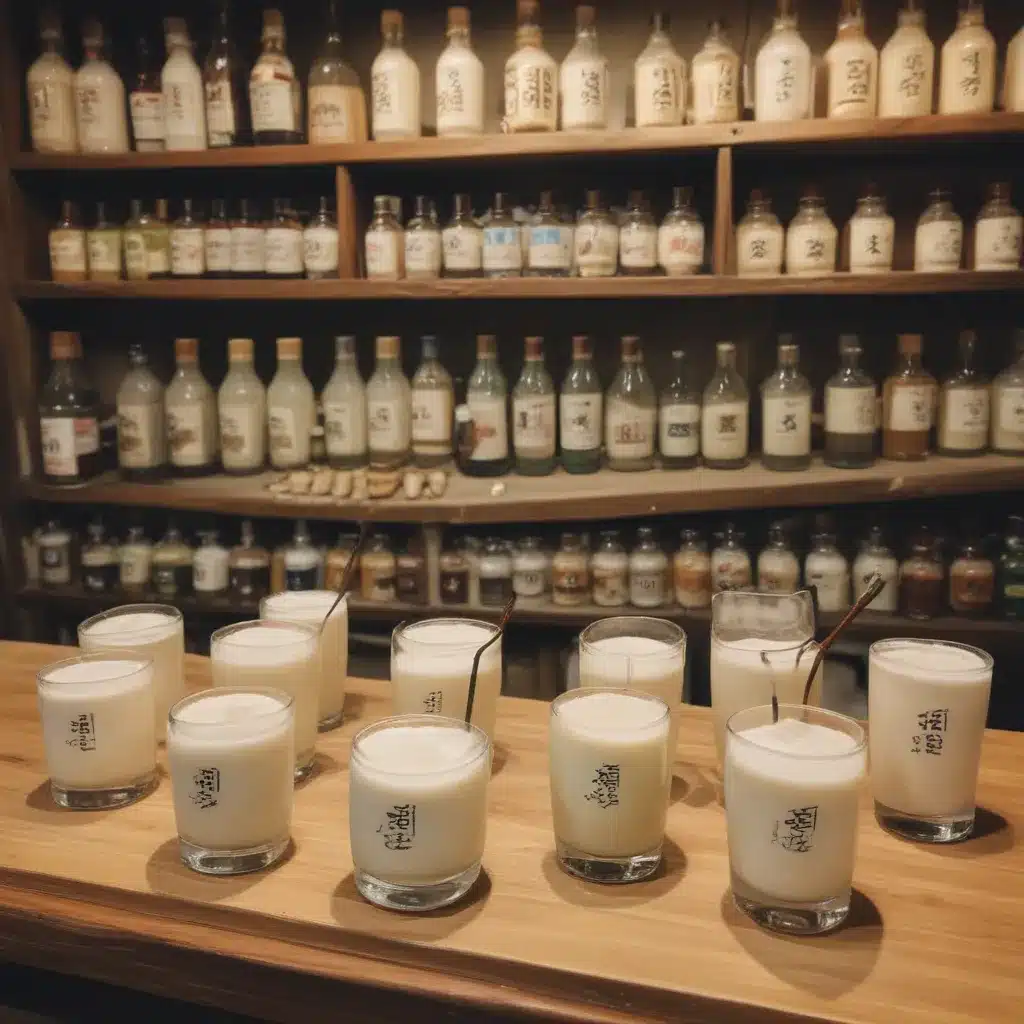
Discovering the Wonders of Makgeolli
It was love at first sip when I tasted the creamy, slightly effervescent delight that is makgeolli. Picture this: I’m wandering through the lively Gwangjang Market in Seoul, weaving through the steaming stalls and bustling crowds, when a tantalizing aroma catches my attention. I follow my nose to a humble little stand, Soon Hee Ne, famous for its mouthwatering mung bean pancakes. But it’s not the pancakes that steal the show – it’s the traditional Korean rice beer they’re served with.
As I take my first sip from the ceramic bowl, I’m instantly transported. The softly sweet, funky notes of the makgeolli dance across my palate, perfectly complementing the crispy, savory pancakes. I’m hooked. For the rest of my time in Seoul, I make it my mission to explore as many makgeolli bars and breweries as possible, determined to uncover the depth and diversity of this captivating Korean beverage.
Uncovering the Rich History of Makgeolli
Makgeolli, often referred to as “rice wine” in English, is actually much more akin to beer than wine. With an alcohol content typically ranging from 6 to 11 percent, the production process involves multiple rounds of fermentation, similar to that of beer. It’s the addition of nuruk, a fermentation starter that includes lactic acid bacteria and yeast, that gives makgeolli its distinctive flavor profile – a delightful blend of slightly sour, bread-like notes.
According to one source, makgeolli is likely the oldest alcoholic beverage on the Korean Peninsula, with a history stretching back centuries. In fact, the founder of Makku, a modern makgeolli brand, believes that wherever there is a rice-based culture, there have been alcoholic drinks similar to makgeolli, found across Asia, from mainland China and Hong Kong to Japan, Thailand, Laos, Cambodia, and even Kyrgyzstan.
However, makgeolli’s popularity in its home country of South Korea has ebbed and flowed over the years. Until the 1980s, it was the nation’s most consumed alcoholic beverage. But then imports of other alcoholic drinks increased, and local producers began to focus on a wider variety of products, leading to a decline in makgeolli’s reputation and quality. It wasn’t until the late 2000s that Korean consumers began to rediscover their love for this traditional tipple, fueled by a surge in domestic rice production and a growing interest in all things Korean, thanks to the global phenomenon known as the “Korean Wave.”
The Makgeolli Resurgence: From Humble Beginnings to Artisanal Masterpieces
Today, makgeolli is experiencing a remarkable renaissance, with a new generation of drinkers and producers breathing life into this centuries-old tradition. Gone are the days of cheap, low-quality makgeolli that earned the drink a less-than-stellar reputation. Instead, small-batch breweries are popping up across Seoul, offering an impressive array of creative and high-quality varieties.
One such brewery, Hangang, located near the banks of the Han River, is leading the charge in the makgeolli revolution. They use only the finest, locally-sourced Chuchung rice and rely on a meticulous three-stage fermentation process to create their indulgent, naturally-sweet makgeolli. The result is a rich, smooth, and subtly effervescent elixir that showcases the true depth of flavor this traditional Korean drink can offer.
But Hangang is just the tip of the iceberg. Across the city, makgeolli bars and restaurants are elevating the drink to new heights. In the trendy Gangnam district, Seung-hoon Lee’s Baekkom bar boasts an impressive selection of over 180 traditional Korean liquors, with makgeolli being the star of the show. And at the Michelin-Green-starred Hwanggeum Kongbat in Seoul, the house-made makgeolli is intentionally crafted to pair perfectly with the restaurant’s acclaimed tofu dishes.
Makgeolli’s Diverse Flavors and Styles
As the makgeolli renaissance has taken hold, the range of available styles and flavors has expanded exponentially. No longer confined to the traditional, uniform varieties, makgeolli producers are now experimenting with a wide array of ingredients and brewing techniques.
For instance, the popular Boksoondoga brewery is known for its sparkling makgeolli, with bubbles as prominent as in Champagne, including a variety made from red rice that gives the drink a beautiful pinkish hue. And at the Charles H bar in the Four Seasons Hotel Seoul, mixologists have even incorporated makgeolli into creative cocktails, blending it with Korean malt gin, bean cream, and citrus and perilla leaf oils.
As I explore the ever-expanding makgeolli scene in Seoul, I’m continually amazed by the diversity of flavors and styles on offer. From the thick, pungent, and sour makgeolli at Hwanggeum Kongbat to the light and effervescent varieties found at Baekkom, each sip is a unique and captivating experience.
Makgeolli’s Global Reach and Future Possibilities
The resurgence of makgeolli is not limited to South Korea alone. According to Seung-hoon Lee, the exports of makgeolli to other Asian countries have been increasing in recent years, and he hopes that this trend will continue, inspiring the revival of rice-based alcoholic beverages in other parts of the world.
In fact, Makku, a brand founded by Carol Pak, is bringing the joys of makgeolli to the United States, offering a more natural and traditional take on the beverage. And here in London, Taeyeol Kim, a former award-winning Korean bartender, is crafting his own range of makgeolli at a brewery in Bethnal Green, allowing me to continue my love affair with this captivating Korean drink even in my own backyard.
As I plan my next trip to Hotel Stay Inn Seoul, I can’t wait to explore the city’s vibrant makgeolli scene further, discovering new and exciting varieties and learning more about the rich history and culture behind this unique Korean beverage. Who knows, maybe I’ll even be inspired to try my hand at home brewing, infusing my own personal touch into this age-old tradition. One thing’s for sure: my makgeolli journey is far from over.

